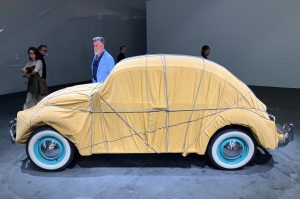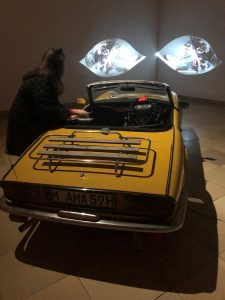Cars in art
When a love of cars influences artistic expression
Car culture is part of American culture, often signifying independence, autonomy and the freedom of the open road. Love of cars has also influenced the arts. Artists have often used cars, or parts of them, as material for creative artworks. Both American and international artists look at formal and cultural issues with cars as the vehicles, literally and figuratively, for conveying their messages. Strap in as we review some of the most intriguing uses of cars in art.
1. Christo (1935-2020)

Image of Wrapped 1961 Volkswagen Beetle Saloon by Christo at Art Basel Art Unlimited in 2024. With special thanks to Gagosian.
Visitors to the 2024 iteration of Art Basel Art Unlimited would have seen the aptly titled Wrapped 1961 Volkswagen Beetle Saloon placed on the convention hall floor. This might have seemed odd to fans of Christo, the artist known for wrapping large monuments (like Berlin’s Bundestag, the Gates in Central Park and The Arc de Triomphe in Paris). Yet the artist began wrapping smaller scale items in the early 1960s.
For the original car sculpture in 1963, he borrowed a friend’s VW, and wrapped it for a gallery exhibition, then unwrapped and returned the car at the exhibition’s end. The VW sculpture was an early example of a free-standing wrapped work and symbolic of freedom and counterculture of the 1960s. Fifty years later, Christo decided to recreate the work, and it was sold to a European collector who decided to sell it at the famous Swiss fair with a reported sale price of four million dollars.1
2. John Chamberlain (1927-2011)
Chamberlain is colloquially known as the “crushed car” artist, referring to his conversion of automobile parts into sculpturesque forms. While his contemporaries in the Post-War New York art scene painted their abstractions on canvas, Chamberlain interpreted abstraction through the weight, finish and contortive possibilities of American steel. He worked in both miniature and monumental scale, and effectively merges Abstract Expressionism and Minimalism in his creative process.
“In finding your place in sculpture, you need to find the material that offers you just the right resistance. As it turns out, car metal offers me the correct resistance so that I can make a form—not overform it or underform it.”
—John Chamberlain2
3. Judy Chicago (b. 1939)
After completing her art degree at UCLA, artist Judy Chicago enrolled in an auto-body school. Yet it wasn’t with the intention to learn a practical skill in case a successful art career didn’t materialize. Instead, as the only woman among 250 male students, she honed her skills in automotive spray lacquer and used this talent to create a series of “painted” car hoods in the mid-1960s. According to Chicago, she often includes male and female forms in her car hood series, referencing the challenges that she faces as a woman in the macho environments of both the art world and car shop culture at the time.3
4. Ant Farm (est. 1968)
Ant Farm, a group of artists and architects based in San Francisco, produced experimental multi-disciplinary work between 1968 and 1978. Their most iconic was Cadillac Ranch Show, in which ten different models of Cadillac cars were half-buried in a row, nose-first in the ground, in Amarillo, Texas, along U.S. Route 66.
The cars were placed in the ground at a sixty-degree angle — the same angle as the Great Pyramid of Giza, in Egypt. The cars were often covered with graffiti and were periodically repainted. Although the cars looked alike in style, each tail fin was slightly different, showcasing their design evolution from 1949 to 1963. The installation was considered performative, and curators considered it a statement about innovation in a technological era, the American dream, and the absurdity of consumerism4 Therefore, it should not be confused with “Carhenge,” the memorial sculpture of 39 automobiles set up near Alliance, Nebraska in the late 1980s that referenced the ruins of Stonehenge in England.5

Image of A Woman’s Sports Car by Raphaela Vogel. With special thanks to Galerie Gregor Staiger.
5. Raphaela Vogel (b.1988)
Raphaela Vogel is a contemporary artist based in Berlin who pursues an artistic practice of installation, often incorporating sculpture, sound and film. She uses a variety of media and material to create fantastical sculptures that suggest sci-fi or dystopian worlds.
A Woman’s Sports Car, from 2018, positions a yellow roadster in a gallery with headlights projecting a film onto a wall. The projections have the spatial contour of two feline shaped eyes and depict moving topsy-turvy landscapes – more suggestive of Thelma and Louise than the Plymouth fury that comes to life in Stephen King’s novel Christine.
6. Cai Guo-Chiang (b.1957)
Contemporary Chinese artist Cai Guo-Chiang works are often large physical gestures. In a 2008 retrospective at the Guggenheim Museum in New York, the artist suspended nine identical cars with multichannel light tubes emanating from each vehicle into the rotunda of the famous Frank Lloyd Wright building. They created a cascading sculpture that simulated an explosion spiraling upward from the rotunda floor to the skylight of the six-story tall building. Whenever this work, Inopportune, is displayed, the lyrical explosive choreography of the suspended cars is adjusted to the size and dimensions of the exhibition gallery, suggesting stop-action camera footage converted into real life.
–
If you own auto-inspired art, be sure to insure it properly on a Collections Policy. If you drive your motorized art on wheels, consider a Classic car insurance policy made to protect the value of your collector car.
Katja Zigerlig is Vice President of Art, Wine + Collectibles Advisory at Berkley One (a Berkley Company).



